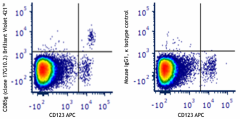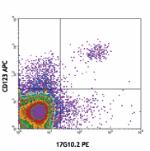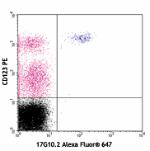- Clone
- 17G10.2 (See other available formats)
- Regulatory Status
- RUO
- Other Names
- CD85g, immunoglobulin-like transcript 7, LILRA4
- Isotype
- Mouse IgG1, κ
- Ave. Rating
- Submit a Review
- Product Citations
- publications

-

Human peripheral blood mononuclear cells were stained with anti-human CD123 APC and anti-human CD85g (ILT7) (clone 17G10.2) Brilliant Violet 421™ (left) or mouse IgG1, κ Brilliant Violet 421™ isotype control (right).
| Cat # | Size | Price | Quantity Check Availability | Save | ||
|---|---|---|---|---|---|---|
| 326419 | 25 tests | £130 | ||||
| 326420 | 100 tests | £271 | ||||
ILT7 (immunoglobulin-like transcript 7) is a member of leukocyte immunoglobulin-like receptor (LIR or LILR) gene family, also known as CD85g and LILRA4. It contains four extracellular Ig domains. In association with FcεR1γ, ILT7 forms a receptor complex that transduces ITAM-mediated signals. ILT7 is specifically expressed on plasmacytoid dendritic cells (pDCs), but not on myeloid dendritic cells and other peripheral blood leukocytes. ILT7 negatively regulates the innate immune functions of human pDCs. Cross-linking 17G10.2 antibody is able to trigger ILT7 mediated signaling.
Product DetailsProduct Details
- Verified Reactivity
- Human
- Antibody Type
- Monoclonal
- Host Species
- Mouse
- Formulation
- Phosphate-buffered solution, pH 7.2, containing 0.09% sodium azide and BSA (origin USA)
- Preparation
- The antibody was purified by affinity chromatography and conjugated with Brilliant Violet 421™ under optimal conditions.
- Concentration
- Lot-specific (to obtain lot-specific concentration and expiration, please enter the lot number in our Certificate of Analysis online tool.)
- Storage & Handling
- The antibody solution should be stored undiluted between 2°C and 8°C, and protected from prolonged exposure to light. Do not freeze.
- Application
-
FC - Quality tested
- Recommended Usage
-
Each lot of this antibody is quality control tested by immunofluorescent staining with flow cytometric analysis. For flow cytometric staining, the suggested use of this reagent is 5 µL per million cells in 100 µL staining volume or 5 µL per 100 µL of whole blood. It is recommended that the reagent be titrated for optimal performance for each application.
Brilliant Violet 421™ excites at 405 nm and emits at 421 nm. The standard bandpass filter 450/50 nm is recommended for detection. Brilliant Violet 421™ is a trademark of Sirigen Group Ltd.
Learn more about Brilliant Violet™.
This product is subject to proprietary rights of Sirigen Inc. and is made and sold under license from Sirigen Inc. The purchase of this product conveys to the buyer a non-transferable right to use the purchased product for research purposes only. This product may not be resold or incorporated in any manner into another product for resale. Any use for therapeutics or diagnostics is strictly prohibited. This product is covered by U.S. Patent(s), pending patent applications and foreign equivalents. - Excitation Laser
-
Violet Laser (405 nm)
- Application Notes
-
Additional reported (for the relevant formats) applications include: trigger ILT7 mediated signaling.The Ultra-LEAF™ purified antibody (Endotoxin < 0.01 EU/µg, Azide-Free, 0.2 µm filtered) is recommended for functional assays (Cat. No. 326413 and 326414).
-
Application References
(PubMed link indicates BioLegend citation) -
- Jensen MA, et al. 2013. Ann Rheum Dis. 72:596. PubMed.
- RRID
-
AB_3083309 (BioLegend Cat. No. 326419)
AB_3083309 (BioLegend Cat. No. 326420)
Antigen Details
- Structure
- Associate with FcεR1γ leukocyte immunoglobulin-like receptor gene family
- Distribution
-
Plasmacytoid dendritic cells
- Function
- Negatively regulates pDC mediated innate immune function
- Cell Type
- Dendritic cells
- Biology Area
- Immunology, Innate Immunity
- Molecular Family
- CD Molecules
- Antigen References
-
1. Cao W, et al. 2006. J. Exp. Med. 203(6):1399.
2. Brown D, et al. 2004. Tissue Antigen. 64:215.
3. Rissoan MC, et al. 2002. Blood 100:3295. - Gene ID
- 23547 View all products for this Gene ID
- UniProt
- View information about CD85g on UniProt.org
Related Pages & Pathways
Pages
Related FAQs
- What is the F/P ratio range of our BV421™ format antibody reagents?
-
It is lot-specific. On average it ranges between 2-4.
Other Formats
View All CD85g (ILT7) Reagents Request Custom Conjugation| Description | Clone | Applications |
|---|---|---|
| PE anti-human CD85g (ILT7) | 17G10.2 | FC |
| Alexa Fluor® 647 anti-human CD85g (ILT7) | 17G10.2 | FC |
| Ultra-LEAF™ Purified anti-human CD85g (ILT7) | 17G10.2 | FC,FA |
| TotalSeq™-C0409 anti-human CD85g (ILT7) | 17G10.2 | PG |
| TotalSeq™-B0409 anti-human CD85g (ILT7) | 17G10.2 | PG |
| Brilliant Violet 421™ anti-human CD85g (ILT7) | 17G10.2 | FC |
| Spark Red™ 718 anti-human CD85g (ILT7) (Flexi-Fluor™) | 17G10.2 | FC |
Compare Data Across All Formats
This data display is provided for general comparisons between formats.
Your actual data may vary due to variations in samples, target cells, instruments and their settings, staining conditions, and other factors.
If you need assistance with selecting the best format contact our expert technical support team.
-
PE anti-human CD85g (ILT7)

CD14- human peripheral blood mononuclear cells st... -
Alexa Fluor® 647 anti-human CD85g (ILT7)

Human peripheral blood mononuclear cells stained with CD123 ... -
Ultra-LEAF™ Purified anti-human CD85g (ILT7)
-
TotalSeq™-C0409 anti-human CD85g (ILT7)
-
TotalSeq™-B0409 anti-human CD85g (ILT7)
-
Brilliant Violet 421™ anti-human CD85g (ILT7)

Human peripheral blood mononuclear cells were stained with a... -
Spark Red™ 718 anti-human CD85g (ILT7) (Flexi-Fluor™)
 Login / Register
Login / Register 














Follow Us